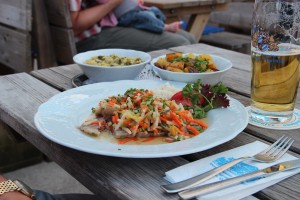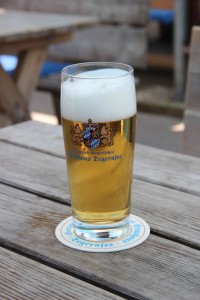This posts should not only be considered Bavarian, but is in my opinion relevant in all German speaking areas, communities and also individual homes.

Schnitzel and Potato Salad
The most famous here would be the “Wiener Schnitzel” (Viennese Cutlet) which could be the original in this what could be locally considered a “Food Group”. It distinguishes itself by being made out of veal. To prepare them follow the Schnitzel recipe below but substitute the pork cutlets with the higher priced veal cutlets (Veal Scallopini). This pork variation would be listed on German menus as “Wiener Art” (Vienesse style).
The Bavarian and in general German counterpart is the Schweineschnitzel (Pork cutlet) which is a standard on the menu of almost every German restaurant and usually a safe bet to order if you are not the adventurous type to try the local fare, as this is a stable like the basic hamburger here in the USA. The recipe can be found at our ingeskitchen.com website. Usually it is served there with a “gemischter Salat” (mixed salad) which could include some potato salad, leaf lettuce, cucumber salad, red beets, coleslaw, tomato salad or other salads the chef creates, as you can see in the pictures below. It is also served with a lemon wedge which you should squeeze out over the Schnitzel.
 Gemischter Salat |
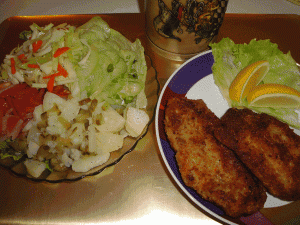 Schnitzel with gemischter Salat |
Now to some of the many variations you might find on menus during your visit to a German restaurant.
Schnitzel Wiener Art: (Schnitzel Viennese style) describes that the meat is breaded but is usually made out of pork (Schweineschnitzel)
Holsteiner Schnitzel: is a basic Schnitzel topped with a fried egg and might include anchovies and capers.
Zigeunerschnitzel (Gypsy Schnitzel): served with a green and red pepper and onion sauce.
Rahmschnitzel: topped with a white gravy made with heavy cream.
Jägerschnitzel (Hunter Schnitzel): Rahmschnitzel gravy that includes wild mushrooms.
Cordon Bleu: same category stuffed with ham and cheese.
even Veal Parmigiana, a Schnitzel topped with tomato sauce, mozzarella and Parmesan cheese would fall into this category
Other variations include the same types as mentioned above but made out of chicken or turkey breast.
Not all Schnitzel are breaded. As the name “Schnitzel” refers to the way it is cut and is translated in English as cutlet. So you will also come across the
Naturschnitzel: a seasoned cutlet fried or BBQ’d and this again can be served with a wide variety of sauces like Hollandaise, Bearnaise, tomato – just to name a few and toppings like cheese, pineapples, mushrooms and even Zucchini, the ever so delicious Veal Oscar is also part of this category.
You can also roll this meat and stuff it with ingredients like spinach, butter sauce and some recipes even call for stronger cheeses like Limburger or Tilsiter.
Let us end this post with one of our favorite recipes for a dinner party
Heidi’s Schnitzel in Cream Sauce.
Excellent, as this has to be made the day ahead, and it is always well like with our guests.
 Schnitzel and Potato Salad |
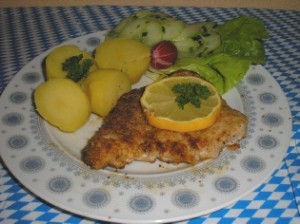 Schnitzel with Potatoes and Cucumber Salad |
Recipes for the above dishes will be published on ingeskitchen.com when available.
 Original post by H.-G. in Bayrisches Allerei
Original post by H.-G. in Bayrisches Allerei In close proximity to the tree is the Pöhlmann’sche Gastwirtschaft located. An old, traditional Franken Gastwirtschaft/Pub with a pergola covered by the branches of a Linden/Basswood tree. This is the location of their charming beer garden.
In close proximity to the tree is the Pöhlmann’sche Gastwirtschaft located. An old, traditional Franken Gastwirtschaft/Pub with a pergola covered by the branches of a Linden/Basswood tree. This is the location of their charming beer garden. This restaurant is usually only open in the evening. They serve the excellent beers associated with this area such as from the “Kulmbacher Kommunbräu” and the brewery “Brauerei Huppendorf“. Hearty, delicous Brotzeits, assorted lunch-meat and cheese plates are served at a reasonable price.
This restaurant is usually only open in the evening. They serve the excellent beers associated with this area such as from the “Kulmbacher Kommunbräu” and the brewery “Brauerei Huppendorf“. Hearty, delicous Brotzeits, assorted lunch-meat and cheese plates are served at a reasonable price.









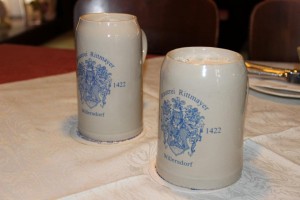
 The Linde or Linden (plural) –
The Linde or Linden (plural) –














 This quiet, small town in the northeast corner of Bavaria is very close to the
This quiet, small town in the northeast corner of Bavaria is very close to the  I worked out a full
I worked out a full 















 This vineyard has been in the possession of the Steinmetz family since 1875 and the restaurant with it’s beer/wine garden is considered a local “secret”, as too many patrons already know about it and it is usually hard to find a seat in the establishment. This might also be due to the fact that they are only open 4 days a week and closed every last Saturday and Sunday of the month.
This vineyard has been in the possession of the Steinmetz family since 1875 and the restaurant with it’s beer/wine garden is considered a local “secret”, as too many patrons already know about it and it is usually hard to find a seat in the establishment. This might also be due to the fact that they are only open 4 days a week and closed every last Saturday and Sunday of the month.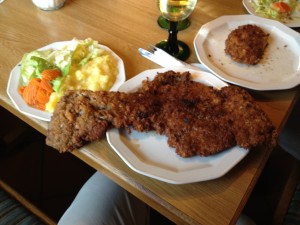



 Overlooking the city of
Overlooking the city of  Here you can enjoy excellent Bavarian cuisine and the top notch beers of the Tegernsee Brewery. The well rounded menu also includes dishes with
Here you can enjoy excellent Bavarian cuisine and the top notch beers of the Tegernsee Brewery. The well rounded menu also includes dishes with 



